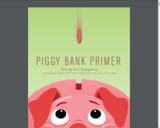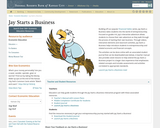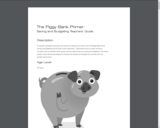
This jeopardy style interactive reviews social studies content.
- Subject:
- Social Studies
- Material Type:
- Presentation
- Provider:
- Jeopardy Labs
- Date Added:
- 08/09/2017

This jeopardy style interactive reviews social studies content.

In this activity, students decide which of their two favorite things they want to buy from their list in Activity 2. This activity is the companion to the Lesson 2: My Favorite Things. Activity is found on pages 14-17 of the pdf.

In this lesson, students demonstrate the making of Crayola products to introduce natural, capital, and human resources as well as touching on some other aspects in the Crayola industry, such as producers and consumers.

In this lesson, students will select resources that would be useful for space travel with scarcity in mind, work cooperatively in groups to reach decisions, and experience the outcome of their choices and recognize that setting criteria can improve their chances for success.

In this lesson, students share several chapters from the book Shoeshine Girl, by Clyde Robert Bulla, to learn about the role of money, labor, earning income, positive and negative incentives, and improving human capital and productivity. Students complete a worksheet on earning money, discuss possible careers, and complete an activity that shows the importance of learning and practicing new skills.

Students consider the different places where food comes from and how the food they eat is transported to them from a source location.

In this lesson, students will investigate the term commodity and its relationship to agriculture. From previous work, students know that agriculture includes food, fiber, natural resources and that farmers produce different items. Students have learned that depending on where people live, there are different crops and foods consumed. Note: This lesson was created in accordance with the VIF Global Competence Indicators for Grade 4. For more information about VIF and these indicators, please visit https://www.vifprogram.com/. This lesson was developed by Brenda Todd as part of their completion of the North Carolina Global Educator Digital Badge program. This lesson plan has been vetted at the local and state level for standards alignment, Global Education focus, and content accuracy.

In this lesson, students research imports and exports for various countries around the globe and discuss the effect on the global economy. Note: This lesson was created in accordance with the VIF Global Competence Indicators for Grade 4. For more information about VIF and these indicators, please visit https://www.vifprogram.com/. This lesson was developed by Brenda Todd as part of their completion of the North Carolina Global Educator Digital Badge program. This lesson plan has been vetted at the local and state level for standards alignment, Global Education focus, and content accuracy.

In this lesson, students learn about supply and demand and the logistics of how commodities get from a source location to the consumer. Note: This lesson was created in accordance with the VIF Global Competence Indicators for Grade 4. For more information about VIF and these indicators, please visit https://www.vifprogram.com/. This lesson was developed by Brenda Todd as part of their completion of the North Carolina Global Educator Digital Badge program. This lesson plan has been vetted at the local and state level for standards alignment, Global Education focus, and content accuracy.

In this lesson, students explore how food choices vary around the world and how this is dependent upon availability and costs. Note: This lesson was created in accordance with the VIF Global Competence Indicators for Grade 4. For more information about VIF and these indicators, please visit https://www.vifprogram.com/. This lesson was developed by Brenda Todd as part of their completion of the North Carolina Global Educator Digital Badge program. This lesson plan has been vetted at the local and state level for standards alignment, Global Education focus, and content accuracy.

In this lesson, students will continue to investigate the term commodity and its relationship to agriculture. Students will also review how agriculture is different and the same in other areas of the world, and discover, through their investigations, the importance of international agriculture. Note: This lesson was created in accordance with the VIF Global Competence Indicators for Grade 4. For more information about VIF and these indicators, please visit https://www.vifprogram.com/. This lesson was developed by Brenda Todd as part of their completion of the North Carolina Global Educator Digital Badge program. This lesson plan has been vetted at the local and state level for standards alignment, Global Education focus, and content accuracy.

In this lesson, students participate in a simulation activity to learn about fair trade. Note: This lesson was created in accordance with the VIF Global Competence Indicators for Grade 4. For more information about VIF and these indicators, please visit https://www.vifprogram.com/. This lesson was developed by Brenda Todd as part of their completion of the North Carolina Global Educator Digital Badge program. This lesson plan has been vetted at the local and state level for standards alignment, Global Education focus, and content accuracy.

In this lesson, students collaborate, communicate, and synthesize new learning about the importance of agriculture to society. This is the culminating lesson in the unit, that pulls all lessons (1-11) together. Note: This lesson was created in accordance with the VIF Global Competence Indicators for Grade 4. For more information about VIF and these indicators, please visit https://www.vifprogram.com/. This lesson was developed by Brenda Todd as part of their completion of the North Carolina Global Educator Digital Badge program. This lesson plan has been vetted at the local and state level for standards alignment, Global Education focus, and content accuracy.

With this lesson, students experience creating a budget and starting a simple business. Students use economic terms as well as experience the market or free-enterprise system.

With this lesson, students learn about business and economics in the free enterprise system focusing on individuals, such as Milton Hershey, Wallace Amos, and Sam Walton.

This resource provides students with the basic concepts and the reality of entrepreneurship. It lists the personal qualities successful entrepreneurs have and it encourages people to gain experience in their venture by first working for someone else in the field of their interest to gain relevant experience.

In this lesson, students learn about the traits and characteristics of entrepreneurs.

Jay's interactive adventure allows students to choose their own adventure as they walk through the process of starting their own business. Through videos, interactive elements and classroom activities, Jay Starts a Business helps introduce students to entrepreneurship and related economic and financial concepts. NOTE: You must right-click "Launch Jay Starts a Business" and choose "Open link in a new tab" to access the interactive resource.

In this lesson, students learn and explain that everyone has wants that are satisfied by consuming goods and services. Lesson is found on pages 8-10 of the pdf.

This is a folktale retold by Jan Brett about a little boy whose grandmother knits him a pair of snow white mittens. While he is outside he loses one and some animals, one by one, find it and move in because it looks warm. This story demonstrates scarcity of space and what happens when this occurs.